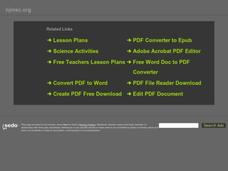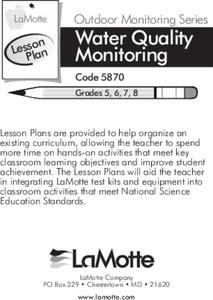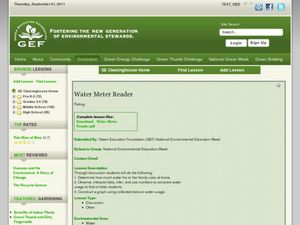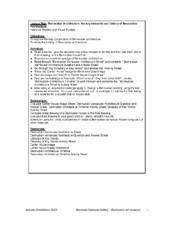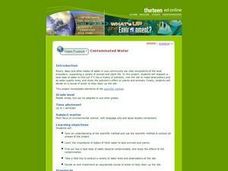Curated OER
Air-Plant Interaction
First graders observe, measure, and predict the growth of bean seedlings. They construct graphs of their findings after altering the temperature of the air for the seedlings. They deduct what would happen if the temperature was much lower.
Curated OER
Water Quality Monitoring
Learners study the water quality of a stream in their area, by measuring the temperature, pH, alkalinity and conductivity. They integrate biology with earth science when using the microscope to study the living organisms in the water.
Curated OER
Black Pearls
Students examine where pearls come from and where mollusks are found. They discover how pearls are formed in nature and how they are they made by humans. They use ordinary oyster shells to examine mother of pearl.
Curated OER
Water Quality Monitoring of Natural Water
Students create their own monitoring program for natural water. They collect samples from an appropriate sampling site. They perform chemical and biological analyses of their samples. They present their information to the class.
Curated OER
Water Quality Monitoring of Natural Water
Students set up their own monitoring system. They collect samples from an appropriate sampling site. They analyze data and determine the water quality. They present their information to the class and draw a conclusion.
Curated OER
Everyday vs. Extreme Relationships with Nature
Students examine the interactions with nature and the environment. They discover where water comes from and ways to conserve water. They also examine energy sources and consumption.
Curated OER
Analyze the Results
Students conduct water tests and sample macroinvertebrates from a nearby source to make a general determination about the overall quality of water. They use worksheets and analyze data as part of a larger unit.
Curated OER
Learning Lesson: That Sinking Feeling
Students discover the origin of the Great Ocean Conveyor. They participate in a demonstration showing how salinity and temperature affect water density. They also examine the new sea ice that forms every winter.
Curated OER
Watershed Awareness
Pupils investigate the relationship between upstream influences in their watershed and the watershed's estuary. They apply the scientific process to test a hypothesis while examining the impact of upland activities on estuaries.
Curated OER
Underground Pollution
Fourth graders construct their own aquifer. They discover how water travels underwater and identifies sources of underground pollution. They record their observations and discuss the results.
Curated OER
Oil in Oman 224
Students discuss the impact of oil on the economics and culture of Oman. They make a chart showing life before and after oil/petroleum wealth in Oman and its capitol city, Muscat. They draw scenes showing Muscat before and after,...
Curated OER
Water Meter Reader
Students examine a water bill from their household and examine it to find out how much water is used each month. They read their home water meters at the same time of the day for seven days and then construct a graph using their data.
Curated OER
Daphnia and Algae: A Study of Pond Dynamics
Students observe interrelationships and interdependencies of organisms which may generate stable ecosystems. They also study that living organisms have the capacity to produce infinite sized populations, but environments and resources...
Curated OER
Bermudian Vernacular Architecture
Students, after researching, discussing and analyzing vernacular architecture in detail, answer a question and answer sheet, review an extensive vocabulary of key words, complete an activity sheet on the key words, and critique a...
Curated OER
Science: The Water Cycle
Students examine the various stages of the water cycle. In groups, they complete a hands-on activity by creating model water cycle. Students design posters representing each of the seven stages of the water cycle.
Curated OER
Water Quality
Students are presented with a hypothetical situation to investigate the water quality of the James River. They are given data to analyze and put into the graphic organizer that is included to help solve the problem. The lesson plan...
Curated OER
Contaminated Water
Middle schoolers review and use the steps in the scientific method to complete the experiment. In groups, they research the importance of water to plants and animals in their local area. They examine how water can become contaminated...
Curated OER
Lotic Environment Lesson Plans
Learners create and conduct experiments on a "classroom river habitat." They manipulate the biotic and abiotic factors so that they are able to compare an artificially prepared river model to a naturally occurring lotic ecosystem.
Curated OER
Salinity and Brackish Water Systems
Students are able to tell the difference between brackish and salt water. They also are able to distinguish water qualities specific to each type of water. Students answer various questions about all types of water.
Curated OER
Making a Food Web and Learning About Ecosystems
Third graders examine the difference between a food web and food chain. They also examine the importance of the sun in a food web and food chain. Students understand what happens when you remove parts of the chain.
Curated OER
Snail Observation Exercise
Learners are given a pond snail in a clear glass and asked to make observations on the snail's form and behavior. One of the key ideas is that seemly common subjects (like snails) often have surprising or interesting properties.
Curated OER
Virginia Studies
Students describe life in the Virginia colony. They explain how geography influenced the relocation of Virginia's capital from Jamestown to Williamsburg, to Richmond. Students compare/contrast life in Jamestown and Williamsburg.
Curated OER
Virginia Studies
Students describe life in the Virginia colony. They explain how geography influenced the relocation of Virginia's capital from Jamestown to Williamsburg, to Richmond. Students compare/contrast life in Jamestown and Williamsburg.
Curated OER
Missing Macroinvertebrates
Students investigate the concept of a macroinvertebrate. They observe the presence of increases or decreases in population in order to test for factors that contribute to the extinction of a species. Students predict the likelihood of...



